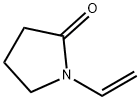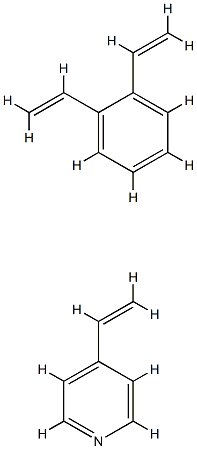2-Vinylpyridine
Synonym(s):α-Vinylpyridine;2-Ethenylpyridine;2-Ethenyl-pyridine;2-Pyridylethylene;2-Vinylpyridine
- CAS NO.:100-69-6
- Empirical Formula: C7H7N
- Molecular Weight: 105.14
- MDL number: MFCD00006355
- EINECS: 202-879-8
- SAFETY DATA SHEET (SDS)
- Update Date: 2025-01-27 09:38:02

What is 2-Vinylpyridine?
Chemical properties
dark brown liquid with an unpleasant odour
Chemical properties
The odor of 2-vinylpyridine can be detected at exposure levels below 1 ppm (v/v). The unpleasant odor can be tolerated at concentrations that can produce acute symptoms and irritation. Special precautions should be taken to avoid skin and eye contact, as well as inhalation of the vapor.
The Uses of 2-Vinylpyridine
2-Vinylpyridine is a pyridine deriviative used in the preparation of poly(2-vinylpyridine) via radical polymerization. 2-Vinylpyridine is used to improve effectiveness of protective polymer coatings o n metals. 2-Vinylpyridine is an impurity of Betahistine (B324000).
The Uses of 2-Vinylpyridine
2-Vinylpyridine is a pyridine derivative used in the preparation of poly(2-vinylpyridine) via radical polymerization. 2-Vinylpyridine is used to improve effectiveness of protective polymer coatings on metals. It is a reagent for pyridylethylation for new protection method for active hydrogen compounds.. It is also used as basic materials for one of largest-selling plastic, manufacturing pharmaceuticals and bio-compounds.
What are the applications of Application
2-Vinylpyridine is a reagent for pyridylethylation
What are the applications of Application
2-vinylpyridine is except being used for fourth pyrrole (butylbenzene pyrrole) latex of synthetic widespread use, and also synthetic etc. for other polymer modification, ion exchange resin, dyeing and printing auxiliary, medicament.
General Description
2-Vinylpyridine (2VP) is a water soluble pyridine derivative that can be used in the synthesis of poly(2-vinylpyridine) (P2VP) by anionic polymerization. It can be industrially prepared by treatment of 2-methylpyridine with an aqueous solution of formaldehyde in a temperature range of 150-200°C.
Flammability and Explosibility
Flammable
Synthesis
The 2-vinylpyridine is mainly prepared from 2-picoline and formaldehyde. The process for synthesizing the 2-vinylpyridine comprises 'two-step' and 'one-step' production processes, and comprises the steps of condensing 2-picoline and formaldehyde to produce hydroxyethyl pyritine; and dehydrating the hydroxyethyl pyritine at a certain temperature in the action of a catalyst to generate the 2-vinylpyridine. The 'one-step' production process is adopted, 2-vinylpyridine is further generated at a certain temperature under the action of an acid catalyst by adopting 2-picoline and formaldehyde as raw materials, the process flow is simple, and the yield is high.
Carcinogenicity
No definitive information on carcinogenicity of the vinylpyridines was found. However, when either 2-vinylpyridine or 4-vinylpyridine was injected intraperitoneally into A/J mice (200 mmol/animal), there was no significant increase in lung adenoma or any other tumors. None was listed as a carcinogen by IARC, OSHA, NTP, and ACGIH.
Purification Methods
Steam distil it, then dry it with MgSO4 and distil it in a vacuum. [Beilstein 20 H 256, 20 III/IV 2884, 20/6 V 211.]
Properties of 2-Vinylpyridine
| Melting point: | -50 °C |
| Boiling point: | 79-82 °C29 mm Hg(lit.) |
| Density | 0.975 g/mL at 25 °C(lit.) |
| vapor pressure | 10 mm Hg ( 44.5 °C) |
| refractive index | n |
| Flash point: | 116 °F |
| storage temp. | Store at -20°C. |
| solubility | 27g/l |
| form | Liquid |
| pka | pK1:4.98(+1) (25°C) |
| color | Clear brown |
| PH | 8 (100g/l, H2O, 20℃) |
| explosive limit | 1.3-10.7%(V) |
| Water Solubility | 2.5 g/100 mL (20 ºC) |
| BRN | 104505 |
| Stability: | Unstable; may be stabilized with a small amount of ter-butyl catechol. Heat sensitive - store cold. Flammable. Incompatible with strong oxidizing agents, strong bases, strong acids. |
| CAS DataBase Reference | 100-69-6(CAS DataBase Reference) |
| NIST Chemistry Reference | Pyridine, 2-ethenyl-(100-69-6) |
| EPA Substance Registry System | 2-Vinylpyridine (100-69-6) |
Safety information for 2-Vinylpyridine
| Signal word | Danger |
| Pictogram(s) |
 Flame Flammables GHS02  Corrosion Corrosives GHS05  Skull and Crossbones Acute Toxicity GHS06  Environment GHS09 |
| GHS Hazard Statements |
H226:Flammable liquids H302:Acute toxicity,oral H311:Acute toxicity,dermal H314:Skin corrosion/irritation H317:Sensitisation, Skin H411:Hazardous to the aquatic environment, long-term hazard |
| Precautionary Statement Codes |
P210:Keep away from heat/sparks/open flames/hot surfaces. — No smoking. P273:Avoid release to the environment. P280:Wear protective gloves/protective clothing/eye protection/face protection. P301+P312:IF SWALLOWED: call a POISON CENTER or doctor/physician IF you feel unwell. P303+P361+P353:IF ON SKIN (or hair): Remove/Take off Immediately all contaminated clothing. Rinse SKIN with water/shower. P305+P351+P338:IF IN EYES: Rinse cautiously with water for several minutes. Remove contact lenses, if present and easy to do. Continuerinsing. |
Computed Descriptors for 2-Vinylpyridine
| InChIKey | KGIGUEBEKRSTEW-UHFFFAOYSA-N |
New Products
4,4-Difluoropiperidine hydrochloride tert-butyl 9-methoxy-3-azaspiro[5.5]undecane-3-carboxylate Indole Methyl Resin N-Isopropylurea N,N-Dicyclohexylcarbodiimide(DCC) MELDRUMS ACID 5-METHYLISOXAZOLE-4-CARBOXYLIC ACID Magnessium Bis glycinate Zinc ascorbate 1-bromo-2-butyne 2-acetamidophenol 9(10H)-anthracenone Erythrosin B, 4-Piperidinopiperidine 2-((4-morpholinophenylamino) (methylthio) methylene) malononitrile 2,4-dihydroxybenzaldehyde 3-(4-morpholinophenylamino)-5-amino-1H-pyrazole-4-carbonitrile Methyl 2-methylquinoline-6-carboxylate 2,6-dichloro-4-nitropyridine 4-Bromo-2-chlorobenzonitrile 2-(benzylamino)acetic acid hydrochloride 4-(tert-Butoxycarbonylamino)but- 2-ynoic acid 3,4-dihydro-2H-benzo[b][1,4]dioxepine 1-Phenyl-1-cycloprppanecarboxylicacidRelated products of tetrahydrofuran








You may like
-
 100-69-6 99%View Details
100-69-6 99%View Details
100-69-6 -
 2-Vinylpyridine (stabilized with TBC) CAS 100-69-6View Details
2-Vinylpyridine (stabilized with TBC) CAS 100-69-6View Details
100-69-6 -
 2-Vinyl pyridine CAS 100-69-6View Details
2-Vinyl pyridine CAS 100-69-6View Details
100-69-6 -
 2-Vinylpyridine CAS 100-69-6View Details
2-Vinylpyridine CAS 100-69-6View Details
100-69-6 -
 3-(4-amino-1-oxoisoindolin-2-yl)-1-methylpiperidine-2,6-dione 98%View Details
3-(4-amino-1-oxoisoindolin-2-yl)-1-methylpiperidine-2,6-dione 98%View Details -
 20677-73-0 (2,2-diethoxyethyl)methylamine 98%View Details
20677-73-0 (2,2-diethoxyethyl)methylamine 98%View Details
20677-73-0 -
 3-(4-(hydroxyamino)-1-oxoisoindolin-2-yl)piperidine-2,6-dione 98%View Details
3-(4-(hydroxyamino)-1-oxoisoindolin-2-yl)piperidine-2,6-dione 98%View Details -
 57381-49-4 2-bromo-4-chlorobenzonitrile 98%View Details
57381-49-4 2-bromo-4-chlorobenzonitrile 98%View Details
57381-49-4
